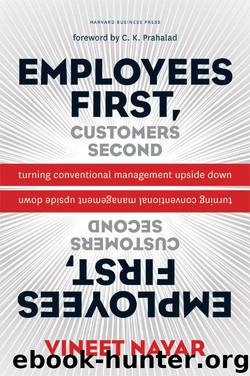Employees First, Customers Second: Turning Conventional Management Upside Down by Vineet Nayar

Author:Vineet Nayar [Nayar, Vineet]
Language: eng
Format: mobi, epub
Published: 2012-02-07T15:56:27.393000+00:00
CHAPTER FOUR
Recasting the Role of the CEO
Transferring the Responsibility for Change
By midwinter of 2006, people throughout HCLT had started to believe in the enormous potential we had as a company. They saw that our commitment to transparency and our efforts to invert the pyramid were making a tangible difference. We were now regularly and successful y competing with the best global players, just as we had vowed we would at our Blueprint meeting. This was satisfying to me, to the leadership team, and to employees throughout the company.
Yet, as I had with each previous phase of the process, I began to look ahead and worry. Just as we had intended, we were starting to speed up our growth. We were taking on hundreds of new people. Although we were stil a relatively smal company, at under $1 bil ion in annual worldwide revenue, we were quite diversified, with operations in eighteen countries in ten vertical areas, and with eight lines of service.
As we grew, how could we sustain our focus on Employees First, Customers Second? Wouldn’t individual units start to rebuild their own traditional pyramid? Wouldn’t new layers of management seek to gain power by aggregating information? How would new people coming on board understand the importance of trust and transparency?
Around that time, I was reading The Starfish and the Spider: The Unstoppable Power of Leaderless Organizations, by Ori Brafman and Rod A. Beckstrom.1 Most companies, they argue, function like eight-legged spiders. “Cut off the leg of a spider, and you have a seven-legged creature on your hands; cut off its head and you have a dead spider,” Beckstrom writes on his Web site. “But cut off the arm of a starfish and it wil grow a new one. Not only that, but the severed arm can grow an entirely new body. Starfish can achieve this feat because, unlike spiders, they are decentralized; every major organ is replicated across each arm.”
At that time, HCLT operated more like a spider than a starfish. For al our openness and transparency, and for al of our inverting of the pyramid, we were stil a highly centralized organization. The CEO and, just as important, the office of the CEO, stil stood at the center of everything, just like the head of the spider.
I saw that we needed to become more like the starfish and that this would require us to rethink the role of the CEO and to transfer much more of the responsibility for change to the employees. Only in that way could we continue to focus on the value zone, put employees first as our company continued to gain in size and scope, and make the change truly sustainable.
I began to look for ways that we could accelerate the transfer.
A Revelation
One day during the winter of 2006 I caught my first glimpse of what the starfish HCLT might look like. The CIO of a global customer was visiting our offices in Delhi to meet with his technical team. I made a point of stopping by to say hel o a few minutes before the meeting got started.
Download
Employees First, Customers Second: Turning Conventional Management Upside Down by Vineet Nayar.epub
This site does not store any files on its server. We only index and link to content provided by other sites. Please contact the content providers to delete copyright contents if any and email us, we'll remove relevant links or contents immediately.
Hit Refresh by Satya Nadella(8854)
The Compound Effect by Darren Hardy(8511)
Change Your Questions, Change Your Life by Marilee Adams(7374)
Nudge - Improving Decisions about Health, Wealth, and Happiness by Thaler Sunstein(7242)
The Black Swan by Nassim Nicholas Taleb(6765)
Deep Work by Cal Newport(6563)
Daring Greatly by Brene Brown(6225)
Rich Dad Poor Dad by Robert T. Kiyosaki(6176)
Principles: Life and Work by Ray Dalio(5961)
Man-made Catastrophes and Risk Information Concealment by Dmitry Chernov & Didier Sornette(5649)
Playing to Win_ How Strategy Really Works by A.G. Lafley & Roger L. Martin(5502)
Digital Minimalism by Cal Newport;(5389)
Big Magic: Creative Living Beyond Fear by Elizabeth Gilbert(5352)
The Myth of the Strong Leader by Archie Brown(5238)
The Slight Edge by Jeff Olson(5200)
Discipline Equals Freedom by Jocko Willink(5157)
The Motivation Myth by Jeff Haden(5004)
Stone's Rules by Roger Stone(4857)
The Laws of Human Nature by Robert Greene(4773)
